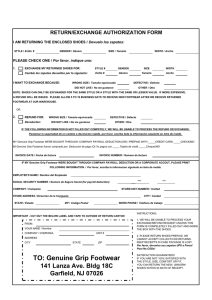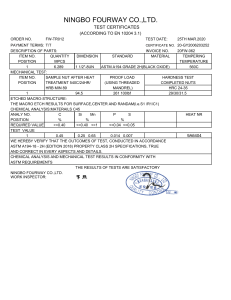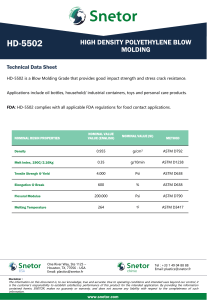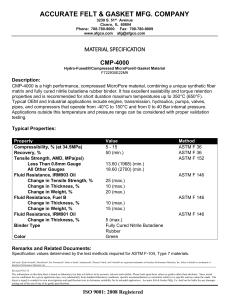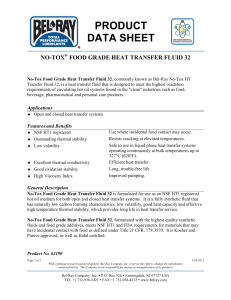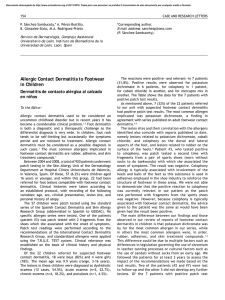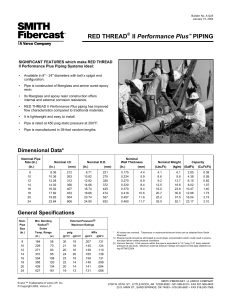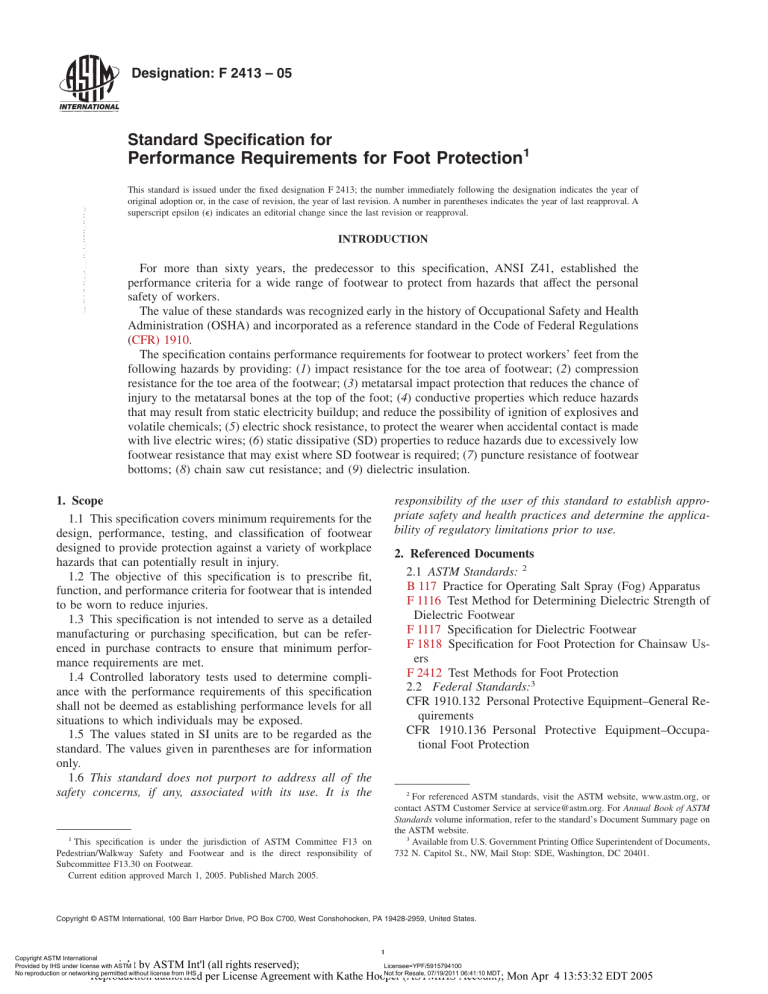
Designation: F 2413 – 05 Standard Specification for Performance Requirements for Foot Protection1 --`,,`,,``,,,,,,``,``,,`````,-`-`,,`,,`,`,,`--- This standard is issued under the fixed designation F 2413; the number immediately following the designation indicates the year of original adoption or, in the case of revision, the year of last revision. A number in parentheses indicates the year of last reapproval. A superscript epsilon (e) indicates an editorial change since the last revision or reapproval. INTRODUCTION For more than sixty years, the predecessor to this specification, ANSI Z41, established the performance criteria for a wide range of footwear to protect from hazards that affect the personal safety of workers. The value of these standards was recognized early in the history of Occupational Safety and Health Administration (OSHA) and incorporated as a reference standard in the Code of Federal Regulations (CFR) 1910. The specification contains performance requirements for footwear to protect workers’ feet from the following hazards by providing: (1) impact resistance for the toe area of footwear; (2) compression resistance for the toe area of the footwear; (3) metatarsal impact protection that reduces the chance of injury to the metatarsal bones at the top of the foot; (4) conductive properties which reduce hazards that may result from static electricity buildup; and reduce the possibility of ignition of explosives and volatile chemicals; (5) electric shock resistance, to protect the wearer when accidental contact is made with live electric wires; (6) static dissipative (SD) properties to reduce hazards due to excessively low footwear resistance that may exist where SD footwear is required; (7) puncture resistance of footwear bottoms; (8) chain saw cut resistance; and (9) dielectric insulation. 1. Scope 1.1 This specification covers minimum requirements for the design, performance, testing, and classification of footwear designed to provide protection against a variety of workplace hazards that can potentially result in injury. 1.2 The objective of this specification is to prescribe fit, function, and performance criteria for footwear that is intended to be worn to reduce injuries. 1.3 This specification is not intended to serve as a detailed manufacturing or purchasing specification, but can be referenced in purchase contracts to ensure that minimum performance requirements are met. 1.4 Controlled laboratory tests used to determine compliance with the performance requirements of this specification shall not be deemed as establishing performance levels for all situations to which individuals may be exposed. 1.5 The values stated in SI units are to be regarded as the standard. The values given in parentheses are for information only. 1.6 This standard does not purport to address all of the safety concerns, if any, associated with its use. It is the 1 This specification is under the jurisdiction of ASTM Committee F13 on Pedestrian/Walkway Safety and Footwear and is the direct responsibility of Subcommittee F13.30 on Footwear. Current edition approved March 1, 2005. Published March 2005. responsibility of the user of this standard to establish appropriate safety and health practices and determine the applicability of regulatory limitations prior to use. 2. Referenced Documents 2.1 ASTM Standards: 2 B 117 Practice for Operating Salt Spray (Fog) Apparatus F 1116 Test Method for Determining Dielectric Strength of Dielectric Footwear F 1117 Specification for Dielectric Footwear F 1818 Specification for Foot Protection for Chainsaw Users F 2412 Test Methods for Foot Protection 2.2 Federal Standards:3 CFR 1910.132 Personal Protective Equipment–General Requirements CFR 1910.136 Personal Protective Equipment–Occupational Foot Protection 2 For referenced ASTM standards, visit the ASTM website, www.astm.org, or contact ASTM Customer Service at service@astm.org. For Annual Book of ASTM Standards volume information, refer to the standard’s Document Summary page on the ASTM website. 3 Available from U.S. Government Printing Office Superintendent of Documents, 732 N. Capitol St., NW, Mail Stop: SDE, Washington, DC 20401. Copyright © ASTM International, 100 Barr Harbor Drive, PO Box C700, West Conshohocken, PA 19428-2959, United States. 1 Copyright by ASTM Int'l (all rights reserved); Licensee=YPF/5915794100 Not for Resale, 07/19/2011 06:41:10 MDT Reproduction authorized per License Agreement with Kathe Hooper (ASTMIHS Account); Mon Apr 4 13:53:32 EDT 2005 Copyright ASTM International Provided by IHS under license with ASTM No reproduction or networking permitted without license from IHS F 2413 – 05 2.3 Canadian Standards Association Standard:4 CAN/CSA Z195 Protective Footwear --`,,`,,``,,,,,,``,``,,`````,-`-`,,`,,`,`,,`--- 3. Terminology 3.1 Definitions: 3.1.1 footwear, n—wearing apparel for the feet (such as shoes, boots, slippers, or overshoes) excluding hosiery. 3.1.1.1 Discussion—This term can refer to either left foot or right foot units or pairs. 3.1.2 insert, n—footbed normally made of a foam product with leather or fabric cover shaped to cover the entire insole which can be inserted between the foot and insole board. 3.1.3 insole, n—foundation of the shoe; the inner sole of the shoe which is next to the foot, under the sock liner or the insert, onto which the upper is lasted. 3.1.4 last, n—solid hinged form, in the general shape of a foot, around which footwear is constructed. 3.1.5 lasting, v—building of footwear around a specific foot form. 3.1.6 lining, n—term used to describe all components that can be used to construct the interior of the upper part of the footwear. 3.1.7 outsole and heel, n—exterior bottom platform of the footwear; the bottom surface. 3.1.8 product category, n—description for a type of footwear designed and manufactured for a specific hazard or hazards. 3.1.9 product classification, n—footwear manufactured to meet a minimum performance requirement for a specific hazard or hazards. 3.1.10 protective footwear, n—footwear that is designed, constructed, and classified to protect the wearer from a potential hazard or hazards. 3.1.11 protective toe cap, n—component designed to provide toe protection that is an integral and permanent part of the footwear. 3.1.12 quarter, n—entire back portion of the footwear upper. 3.1.13 shall, v—mandatory action. 3.1.14 should, v—advisory comment. 3.1.15 size, n—length and breadth measurements of footwear determined by using a specific grading; the American system of footwear grading. 3.1.16 socklining, n—material placed over the insole which is imprinted with a brand name or other designation. 3.1.17 upper, n—parts of a shoe or boot that are above the sole. 4. Significance and Use 4.1 This specification contains requirements to evaluate the performance of footwear for the following: 4.1.1 Impact resistance for the toe area of footwear, 4.1.2 Compression resistance for the toe area of footwear, 4.1.3 Metatarsal protection that reduces the chance of injury to the metatarsal bones at the top of the foot, 4 Available from Canadian Standards Association (CSA), 178 Rexdale Blvd., Toronto, ON Canada M9W1R3. 4.1.4 Conductive properties which reduce hazards that may result from static electricity buildup, and reduce the possibility of ignition of explosives and volatile chemicals, 4.1.5 Electric shock resistance, 4.1.6 Static dissipative (SD) properties to reduce hazards due to excessively low footwear resistance that may exist where SD footwear is required, 4.1.7 Puncture resistance of footwear bottoms, 4.1.8 Chain saw cut resistance, and 4.1.9 Dielectric insulation. 5. Performance Requirements and Workmanship 5.1 Impact Resistant Footwear: 5.1.1 Impact resistant footwear shall also meet the requirements of 5.2 for compression resistant footwear. 5.1.2 Footwear shall be designed, constructed, and manufactured so that a protective toe cap is an integral and permanent part of the footwear. 5.1.3 The workmanship in the production and assembly of the footwear shall ensure that the footwear provides functionality to the wearer. 5.1.4 Classification shall be determined by evaluating three specimens in accordance with Test Methods F 2412. The product classification for impact resistance represents the minimum force required for each classification that results in the toe area of the footwear having a minimum interior height clearance of 12.7 mm (0.50 in.) in men’s footwear and 11.9 mm (0.468 in.) in women’s footwear. 5.1.4.1 Impact resistance of footwear shall be classified as follows: (1) Class 75 product classification men’s footwear shall demonstrate a minimum interior height clearance of 12.7 mm (0.50 in.) during exposure to impact energy of 101.7 J (75 ft-lbf). (2) Class 75 product classification women’s footwear shall demonstrate a minimum interior height clearance of 11.9 mm (0.468 in.) during exposure to impact energy of 101.7 J (75 ft-lbf). (3) Class 50 product classification men’s footwear shall demonstrate a minimum interior height clearance of 12.7 mm (0.50 in.) during exposure to impact energy of 67.8 J (50 ft-lbf). (4) Class 50 product classification women’s footwear shall demonstrate a minimum interior height clearance of 11.9 mm (0.468 in.) during exposure to impact energy of 67.8 J (50 ft-lbf). 5.1.4.2 Any specimen that does not meet the minimum impact performance requirements for the product classification constitutes failure for the product category. 5.1.4.3 Protective toe footwear specimens or samples shall be retested for classification for any of the following changes: (1) Change in material used to make protective toe cap, change in protective cap manufacturer, or changes in the design of the toe cap. (2) Change in construction method used to make footwear. (3) Change in the upper or insole material thickness greater than 25 %, change to the soling system, or a change in the hardness of the outsole. (4) Shape of last used in the manufacturing of footwear. 2 Copyright by ASTM Int'l (all rights reserved); Licensee=YPF/5915794100 Not for Resale, 07/19/2011 06:41:10 MDT Reproduction authorized per License Agreement with Kathe Hooper (ASTMIHS Account); Mon Apr 4 13:53:32 EDT 2005 Copyright ASTM International Provided by IHS under license with ASTM No reproduction or networking permitted without license from IHS F 2413 – 05 5.2 Compression Resistant Footwear: 5.2.1 Compression resistant footwear shall also meet the requirements of 5.1 for impact resistant footwear. 5.2.2 Footwear shall be designed, constructed, and manufactured so that a protective toe cap is an integral and permanent part of the footwear. 5.2.3 The workmanship in the production and assembly of the footwear shall ensure that the footwear provides functionality to the wearer. 5.2.4 Classification shall be determined by evaluating three specimens in accordance with Test Methods F 2412. The product classification for compression resistance represents the minimum force required that results in the toe area of the footwear having a minimum interior height clearance of 12.7 mm (0.50 in.) in men’s footwear and 11.9 mm (0.468 in.) in women’s footwear. 5.2.4.1 Compression resistance of footwear shall be classified as follows: (1) Class 75 product classification men’s footwear shall demonstrate a minimum interior height clearance of 12.7 mm (0.50 in.) during exposure to a compressive force of 11 121 N (2500 lbf). (2) Class 75 product classification women’s footwear shall demonstrate a minimum interior height clearance of 11.9 mm (0.468 in.) during exposure to a compressive force of 11 121 N (2500 lbf). (3) Class 50 product classification men’s footwear shall demonstrate a minimum interior height clearance of 12.7 mm (0.50 in.) during exposure to a compressive force of 7784 N (1750 lbf). (4) Class 50 product classification women’s footwear shall demonstrate a minimum interior height clearance of 11.9 mm (0.468 in.) during exposure to a compressive force of 7784 N (1750 lbf). 5.2.4.2 Any specimen that does not meet the minimum compression resistance requirements for the product classification constitutes a failure for the product category. 5.2.4.3 Compression resistant footwear shall be retested for classification for any of the following changes: (1) Change in material to make protective toe cap, change in protective toe cap manufacturer, or changes in the design of the toe cap. (2) Change in construction method used to make footwear. (3) Change in the upper or insole material thickness greater than 25 %, change to the soling system, or a change in the hardness of the outsole. (4) Shape of last used in manufacturing of footwear. 5.2.4.4 Classifications—Protective footwear shall be classified in accordance with the tables below for its ability to meet compression resistance and impact resistance. The proper classification shall be determined by the test results of three specimens for each requirement. 5.2.4.5 The lowest recorded compression or impact resistance of the three test specimens will determine the footwear classification. If the product fails to meet the class for which it is intended, you must retest. For example, if a product test results meet Class 50 for compression resistance and Class 75 for impact resistance, the rating of the footwear will be I50/C50. Classification Table Impact I/75 = 75 ft-lbs (101.7 J) I/50 = 50 ft-lbs (67.8 J) Classification Table Compression C/75 = 2500 lb (11 121 N) C/ = 1750 lb (7784 N) Minimum Clearance (all classifications) Men = 0.500 in. (12.7 mm) Women = 0.468 in. (11.9 mm) 5.3 Metatarsal Protective Footwear: 5.3.1 Metatarsal protective footwear shall first meet the requirements of 5.1 for impact resistant footwear and 5.2 for compression resistant footwear. 5.3.2 Footwear shall be designed, constructed, and manufactured so that a metatarsal impact guard is positioned partially over the protective toe cap and extended to cover the metatarsal bone area. The metatarsal protection shall be an integral and permanent part of the footwear. 5.3.3 The workmanship in the production and assembly of the footwear shall ensure that the footwear provides functionality to the wearer. 5.3.4 Classification shall be determined by evaluating three specimens in accordance with Test Methods F 2412. The product classification for metatarsal protection shall be made after the footwear has been classified for impact resistance and compression resistance. 5.3.4.1 Class 75 product classification metatarsal protective footwear for men shall first meet the performance requirements for Class 75 Impact Resistant and Class 75 Compression Resistant footwear. Subsequent to meeting these performance requirements, the height of the wax form used to measure metatarsal protection shall be a minimum of 25.4 mm (1.0 in.) after exposure of impact energy of 101.7 J (75 ft-lbf ). 5.3.4.2 Class 75 product classification metatarsal protective footwear for women shall first meet the performance requirements for Class 75 Impact Resistant and Class 75 Compression Resistant footwear. Subsequent to meeting these performance requirements, the height of the wax form used to measure metatarsal protection shall be a minimum of 23.8 mm (0.937 in.) after exposure of impact energy of 101.7 J (75 ft-lbf). 5.3.4.3 Class 50 product classification metatarsal protective footwear for men shall first meet the performance requirements for Class 50 Impact Resistant and Class 50 Compression Resistant footwear. Subsequent to meeting these performance requirements, the height of the wax form used to measure metatarsal protection shall be a minimum of 25.4 mm (1.0 in.) after exposure of impact energy of 67.8 J (50 ft-lbf). 5.3.4.4 Class 50 product classification metatarsal protective footwear for women shall first meet the performance requirements for Class 50 Impact Resistant and Class 50 Compression Resistant footwear. Subsequent to meeting these performance requirements, the height of the wax form used to measure metatarsal protection shall be a minimum of 23.8 mm (0.937 in.) after exposure of impact energy of 67.8 J (50 ft-lbf). --`,,`,,``,,,,,,``,``,,`````,-`-`,,`,,`,`,,`--- Copyright ASTM International Provided by IHS under license with ASTM No reproduction or networking permitted without license from IHS 3 Copyright by ASTM Int'l (all rights reserved); Licensee=YPF/5915794100 Not for Resale, 07/19/2011 06:41:10 MDT Reproduction authorized per License Agreement with Kathe Hooper (ASTMIHS Account); Mon Apr 4 13:53:32 EDT 2005 F 2413 – 05 --`,,`,,``,,,,,,``,``,,`````,-`-`,,`,,`,`,,`--- 5.3.4.5 Any specimen that does not meet the metatarsal impact resistance performance requirement constitutes a failure for the product category. 5.3.4.6 Metatarsal impact resistance protection shall be retested for classification for any of the following changes: (1) Change in material used to produce the metatarsal impact resistant protection device, change in manufacturer, or design of the product, or a combination thereof. (2) Change in construction method used to make footwear. (3) Change in the upper or insole material thickness greater than 25 %, a change to the soling system, or a change in the hardness of the outsole. (4) Shape of last used in manufacturing of footwear. 5.4 Conductive Protective Footwear: 5.4.1 Conductive footwear shall also meet the requirements of 5.1 for impact resistant footwear and 5.2 for compression resistant footwear. 5.4.2 Footwear shall be designed, constructed, and manufactured to provide protection for the wearer against hazards that may result from static electricity buildup and to reduce the possibility of ignition of explosives or volatile chemicals. 5.4.2.1 Footwear shall dissipate static electricity from the body to reduce the possibility of ignition of volatile compounds. 5.4.2.2 Footwear shall be of a construction that facilitates a stable electrically conductive path. All external components shall be made of nonferrous materials. 5.4.2.3 Conductive footwear is not designed to be worn by personnel working near open electrical circuits. 5.4.3 The workmanship in the production and assembly of the footwear shall ensure that the footwear provides functionality to the wearer. 5.4.3.1 The uppers shall be made of materials that facilitate the dissipation of static electricity. 5.4.3.2 The insoles, linings, outsoles, and heels of the footwear shall be made of any combination of materials and compounds which will facilitate electrical conductivity and the transfer of static electricity build up from the body to the ground. 5.4.3.3 The recommended design of the outsole and heel is a single unit. Where the outsole and heel are separate components, the following practices shall be used. (1) Heel shall be attached to outsole to ensure no disruption in electrical conductivity. (2) Non-ferrous heel nails shall be used to attach the heels when heel nails are used. These nails shall be recessed within the tread surface and then covered with conductive material. These nails shall not be either exposed or visible. 5.4.4 Electrical resistance shall be determined by evaluating the minimum number of specimens per lot size in accordance with Test Methods F 2412. 5.4.4.1 The specimens shall demonstrate resistance between 0 to 500 000 ohms. 5.4.4.2 Any specimen or sample of conductive footwear that does not meet the performance requirement constitutes a failure for the lot. 5.5 Electric Shock Resistant Footwear: 5.5.1 Electric shock resistant footwear shall also meet the requirements of 5.1 for impact resistant footwear and 5.2 for compression resistant footwear. 5.5.2 Electric shock resistant footwear shall be designed, constructed, and manufactured with non-conductive electric shock resistant soles and heels so that the footwear outsole can provide a secondary source of electric shock resistance protection to the wearer against the hazards from an incidental contact with live electrical circuits, electrically energized conductors, parts, or apparatus. 5.5.3 Footwear shall have an electrical shock resistant outsole and heel with an outer surface which is not penetrated by electrically conductive components, parts, or conductive materials. 5.5.4 Footwear outsole shall provide a secondary source of protection against incidental contact with live electrical circuits, electrically energized conductors, parts, or apparatus under dry conditions. 5.5.5 Electrical hazard protection is severely deteriorated in the following conditions: excessive wear on the outsole and heel or exposure to wet and humid environments, or both. 5.5.6 The workmanship in the production and assembly of the footwear shall ensure that the footwear provides functionality to the wearer. 5.5.7 The outsoles and heels shall be made of materials designed to offer electrical insulative properties to provide electric shock resistance. 5.5.8 Electric shock resistance of the footwear shall be determined by evaluating the minimum number of specimens per lot size in accordance with Test Methods F 2412. 5.5.8.1 Protective footwear constructed or manufactured to be electrically shock resistant shall be capable of withstanding the application of 14 000 V (root mean square (rms)) at 60 Hz for 1 min with no current flow or leakage current in excess of 3.0 mA under dry conditions. 5.5.9 Any specimen that does not meet the performance requirement constitutes a failure for the lot. 5.6 Static Dissipative (SD) Footwear: 5.6.1 Static dissipative footwear shall also meet the requirements of 5.1 for impact resistant footwear and 5.2 for compression resistant footwear. 5.6.2 Static dissipative footwear shall be designed, constructed, and manufactured to provide protection to the wearer against hazards which may exist due to excessively low footwear resistance in a work environment, as well as maintain a sufficiently high level of resistance to reduce the possibility of electrical shock in work areas where SD footwear is worn. 5.6.2.1 Footwear shall reduce the excess static electricity by conducting the charge (from body) to ground while simultaneously maintaining a sufficiently high level of resistance (106 ohms) (1 megohm) to protect the wearer when exposed to hazards from incidental contact with live electric circuits. 5.6.2.2 Using human subjects, a pair of footwear shall have a lower limit of electrical resistance of 106 ohms (1 megohm) and have an upper limit electrical resistance of 108 ohms (100 megohms). 4 Copyright by ASTM Int'l (all rights reserved); Licensee=YPF/5915794100 Not for Resale, 07/19/2011 06:41:10 MDT Reproduction authorized per License Agreement with Kathe Hooper (ASTMIHS Account); Mon Apr 4 13:53:32 EDT 2005 Copyright ASTM International Provided by IHS under license with ASTM No reproduction or networking permitted without license from IHS F 2413 – 05 5.6.3 The workmanship in the production and assembly of the footwear shall ensure that the footwear provides functionality to the wearer. 5.6.3.1 The footwear shall use any combination of materials that facilitate static dissipation by a consistent path of resistance. 5.6.3.2 The inconsistency of certain hygroscopic materials can result in footwear not being able to consistently meet the performance requirements of static dissipative footwear. 5.6.3.3 Heels shall be attached using non-ferrous heel nails. These nails shall be recessed within the tread surface and then covered with conductive material. These nails shall be neither exposed nor visible. 5.6.4 Static dissipation shall be determined by evaluating the minimum number of specimens per lot size in accordance with Test Methods F 2412. 5.6.4.1 Any specimen that does not meet the performance requirement constitutes a failure for the lot. 5.7 Puncture Resistant Footwear: 5.7.1 Puncture resistant footwear shall also meet the requirements of 5.1 for impact resistant footwear and 5.2 for compression resistant footwear. 5.7.2 Footwear shall be designed, constructed, and manufactured so that a puncture resistant plate is positioned between the insole and outsole and is made an integral and permanent part of the footwear. 5.7.2.1 The puncture resistant components shall reduce the possibility of injury caused by sharp objects that can penetrate the bottom assembly of the footwear. 5.7.3 The workmanship in the production and assembly of the footwear shall ensure that the footwear provides functionality to the wearer. 5.7.3.1 The puncture resistant device shall cover the maximum area of the insole to include as much of the heel area that is allowed by the construction of the footwear and be an integral part of the footwear. 5.7.3.2 The preferred design of the puncture resistant device is a single unit. 5.7.4 Puncture resistance shall be determined by evaluating the minimum number of specimens per lot size in accordance with Test Methods F 2412. 5.7.4.1 The specimens shall demonstrate a minimum puncture resistance on each device of 1200 N (270 lbf). 5.7.5 Measure flex resistance to cracking using CAN/CSA Z195. 5.7.5.1 Puncture resistant devices shall show no signs of cracking after 1.5 million flexes. 5.7.6 Puncture resistant devices shall show no sign of corrosion after being exposed to a 5 % salt solution for 24 h, in accordance with B 117. 5.7.7 Each pair of puncture resistant protective devices shall bear the manufacturer’s name, trademark or logo, or both, and month and year of manufacture. This information shall be permanently stamped or marked in a conspicuous location. 5.7.8 Any specimen that does not meet the performance requirements constitutes a failure for the lot. 5.8 Chain Saw Cut Resistant Footwear: 5.8.1 Footwear shall be designed, constructed, and manufactured so that it can provide protection to the wearer’s feet against the hazards which may result when operating a chain saw. 5.8.1.1 Chain saw cut resistant footwear is intended to protect the foot area between the toe and lower leg when operating a chain saw. 5.8.2 The workmanship in the production and assembly of the footwear shall ensure that the footwear provides functionality to the wearer. These practices shall also meet the requirements of the section on Materials and Workmanship of Specification F 1818. 5.8.2.1 The area of protection shall meet the requirements as stipulated in the section on Areas of Protection of Specification F 1818. 5.8.3 Chain saw cut resistant footwear shall meet the performance requirements of the section on Inspection and Performance Testing of Specification F 1818. 5.8.3.1 Any specimen that does not meet the performance requirements constitutes a failure for the product category. 5.9 Dielectric Insulation: 5.9.1 Footwear shall be designed, constructed, and manufactured so that it can provide additional insulation if accidental contact is made with energized electrical conductors, apparatus, or circuits. 5.9.2 Dielectric insulation shall meet the minimum insulation performance requirements of the section on Electrical Requirements of Specification F 1117 as tested in accordance with Test Method F 1116. 5.9.3 Any specimen that does not meet the performance requirements constitutes a failure for the product category. 6. Hazard Assessment 6.1 In conjunction with the advisory in CFR 1910.132 and CFR 1910.136, the user of this specification should conduct a hazard assessment to determine the specific requirements that are needed for the protective footwear to be worn for each specific work place hazard. 6.2 The classification system and minimum performance requirements for each hazard provide for a zero negative tolerance. Consequently, the assessment and determination of the specific hazards allows for choosing the specific combination of features that the footwear must demonstrate. For example: 6.2.1 One group of workers in a facility would need footwear that is: Class 75 Impact Resistant Class 75 Compression Resistant Electric Shock Resistant 6.2.2 Another group of workers in the same facility would need footwear that is: Class 50 Impact Resistant Class 50 Compression Resistant Class 50 Metatarsal Impact Resistant Electric Shock Resistant 7. Labeling and Identification 7.1 Labeling and identification of protective footwear is essential to ensure the wearer that footwear meets the required minimum performance (see Table 1). --`,,`,,``,,,,,,``,``,,`````,-`-`,,`,,`,`,,`--- 5 Copyright by ASTM Int'l (all rights reserved); Licensee=YPF/5915794100 Not for Resale, 07/19/2011 06:41:10 MDT Reproduction authorized per License Agreement with Kathe Hooper (ASTMIHS Account); Mon Apr 4 13:53:32 EDT 2005 Copyright ASTM International Provided by IHS under license with ASTM No reproduction or networking permitted without license from IHS F 2413 – 05 TABLE 1 Examples of Marking and Identification Identification Description Example A Line 1 ASTM F 2413–05 Line 2 F/I/75/C/75/Mt75 Line 3 EH --`,,`,,``,,,,,,``,``,,`````,-`-`,,`,,`,`,,`--- Protective footwear which complies to the performance requirement of F 2413 issued in 2005. Footwear worn by female worker which has Class 75 impact resistance; Class 75 compression resistance, and Class 75 metatarsal impact resistance. The outsole and heel of this footwear is made with non-conductive materials, shock resistant. Example B Line 1 ASTM F 2413–05 Line 2 M/I/50/C/50 Line 3 Line 4 PR CS Line 1 ASTM F 2413–05 Line 2 M/I/75/C/75 Line 3 CD Protective footwear which complies to the performance requirement of F 2413 issued in 2005. Footwear worn by male worker which has Class 50 impact resistance and Class 50 compression resistance. Puncture resistant footwear Footwear which is chain saw cut resistant. Example C Protective footwear which complies to the performance requirement of F 2413 issued in 2005. Footwear worn by male worker which has a Class 75 impact resistance and a Class 75 compression resistance. Footwear is conductive. 7.1.1 The label uses a specific four line format that identifies the type of footwear and the hazards for which it is designed to provide protection. 7.1.2 Print size on labels shall be clearly visual to the eye and shall measure 3.75 mm (0.125 in.) or larger. 7.1.3 Line 1—Identifies that the footwear is protective footwear that complies to an ASTM standard with a specific year of issuance. For example: ASTM F 2413 (ASTM Standard No.) 05 (Year of issuance) 7.1.4 Line 2—Identifies the gender of user and the classifications for impact resistance, compression resistance, and metatarsal impact resistance. For example: M Male I Impact Resistant Footwear F Female I Impact Resistant Footwear M/I/75/C/75 75 C Impact Compression Classification Resistant Footwear F/I/75/C/75 75 C Impact Compression Classification Resistant Footwear 75 Compression Classification 75 Compression Classification M/I/50/C/50/Mt/50 M I 50 C 50 MT 50 Male Impact Impact Compres- Compres- Metatarsal Metatarsal Resistant Classifi- sion sion Resistant Classification Footwear cation Resistant ClassifiFootwear Footwear cation 7.1.5 Lines 3 and 4—Identifies footwear made to offer protection from specific types of hazards. Section reference shall be in numerical order. 7.1.5.1 CD—Identifies protection against conductive hazards as discussed in 5.4. 7.1.5.2 EH—Identifies footwear with outsole and heel made of electrical insulation properties; shock resistant as discussed in 5.5. 7.1.5.3 SD—Identifies footwear designed to reduce the accumulation of excess static electricity as discussed in 5.6. 7.1.5.4 PR—Identifies footwear designed to be puncture resistant as discussed in 5.7. 7.1.5.5 Mt—Identifies footwear designed to be impact resistant to the top of the foot as discussed in 5.3. 7.1.5.6 CS—Identifies footwear which provides chain saw cut resistance as noted in 5.8. 7.1.5.7 DI—Identifies footwear which provides dielectric insulation as noted in 5.9. 7.1.6 Line 4—Shall only be used when more than three sections of this specification apply to any one pair of protective footwear. 8. Marking and Compliance Requirements 8.1 The marking as defined in this specification indicates that the protective footwear bearing this label meets the minimum requirements for the product category as defined within this specification. 8.2 Responsibility of the Manufacturer or Supplier—The manufacturer or supplier, or both, of the protective footwear bearing the marking shall maintain documentation to identify the product category sampled for testing, a report of tests performed, test results date of testing and identify of the independent testing facility used. 8.3 Compliance Requirements—The manufacturer or supplier, or both, of protective footwear bearing the marking label that is found to be in non-compliance with the requirements of this specification is liable for immediate disqualification from using the ASTM label for that product category. 8.4 The identification of all protective footwear as meeting the requirements of this specification shall follow a consistent pattern. One-half pair shall be clearly and legibly identified in letters and numbers not less than 0.125 in. (3.175 mm) high. The identification shall be either a stitched in, stamped, or pressure-sensitive label, or a combination thereof. The identification shall be enclosed in a border and be placed on either the surface of the tongue, gusset, shaft, or quarter lining. 9. Keywords 9.1 chain saw protection; conductive footwear; dielectric; electric shock resistance (EH); foot protection; impact resistance; metatarsal protection; protective footwear; puncture resistance; safety footwear electrical hazard; static dissipative (ESD) 6 Copyright by ASTM Int'l (all rights reserved); Licensee=YPF/5915794100 Not for Resale, 07/19/2011 06:41:10 MDT Reproduction authorized per License Agreement with Kathe Hooper (ASTMIHS Account); Mon Apr 4 13:53:32 EDT 2005 Copyright ASTM International Provided by IHS under license with ASTM No reproduction or networking permitted without license from IHS F 2413 – 05 ASTM International takes no position respecting the validity of any patent rights asserted in connection with any item mentioned in this standard. Users of this standard are expressly advised that determination of the validity of any such patent rights, and the risk of infringement of such rights, are entirely their own responsibility. This standard is subject to revision at any time by the responsible technical committee and must be reviewed every five years and if not revised, either reapproved or withdrawn. Your comments are invited either for revision of this standard or for additional standards and should be addressed to ASTM International Headquarters. Your comments will receive careful consideration at a meeting of the responsible technical committee, which you may attend. If you feel that your comments have not received a fair hearing you should make your views known to the ASTM Committee on Standards, at the address shown below. This standard is copyrighted by ASTM International, 100 Barr Harbor Drive, PO Box C700, West Conshohocken, PA 19428-2959, United States. Individual reprints (single or multiple copies) of this standard may be obtained by contacting ASTM at the above address or at 610-832-9585 (phone), 610-832-9555 (fax), or service@astm.org (e-mail); or through the ASTM website (www.astm.org). --`,,`,,``,,,,,,``,``,,`````,-`-`,,`,,`,`,,`--- 7 Copyright by ASTM Int'l (all rights reserved); Licensee=YPF/5915794100 Not for Resale, 07/19/2011 06:41:10 MDT Reproduction authorized per License Agreement with Kathe Hooper (ASTMIHS Account); Mon Apr 4 13:53:32 EDT 2005 Copyright ASTM International Provided by IHS under license with ASTM No reproduction or networking permitted without license from IHS
